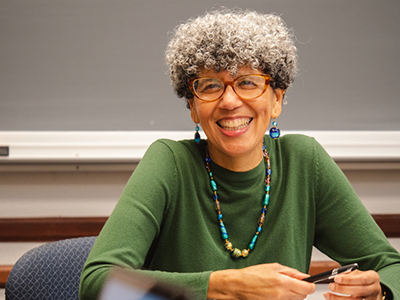Rafia M. Zafar is Professor of English, African & African American Studies and American Culture Studies at Washington University in St. Louis.

Photo credit: Sean Garcia/Washington University in STL, all rights reserved.
In spring 2021 I added Wikipedia as a way of bringing another dimension to my course on African American foodways, in part because I felt that it would make online teaching more compelling. I was moved to do this on the recommendation of a friend in our Biology department who has taught with Wikipedia on more than one occasion. Incorporating Wiki Education into my African American Studies class I saw as a way of getting my students familiar with the digital humanities—a current initiative in Arts & Sciences—as well as raising the level of reliable, publicly accessible information about African American culture: as we know, many people first look to Wikipedia for information about something. The first few weeks of the term I thought—what did I get myself into?—but once we had our first flipped classroom (where we crowd sourced/peer edited in small groups) the light began to dawn on us all. Too, as a faculty newbie I was offered a Wiki Education mentor who talked me through the first jump, as it were, and made himself available for questions throughout. And while I tried not to bother him, knowing he was available for any queries made me more relaxed (and of course I could ask my friend, too).
Among many topics students edited articles on oyster houses (bringing to the fore the significance of African American seafood entrepreneurs), sesame (adding information on the African diasporic origins of the plant), the Cotton Club (expanding public understanding of the racial bias built into the famed supper club), and Black veganism. Prose narratives and/or scholarly sources were improved through the diligence of the undergraduates. Students wrote blog posts and end-of-term reflections in which they discussed not only what they learned about building out the content of Wikipedia but also their new knowledge regarding the use and critiquing of sources.* Some delivered lively end-of-term oral presentations on their findings, including one on collard greens. Two told me the plagiarism exercises on the Wikipedia syllabus were more helpful than what they’d learned elsewhere.**
Probably adding Wikipedia to one’s class is not for everyone. Chief among the wrinkles I faced was syncing the Wiki syllabus with my already developed course syllabus; this at least once necessitated my kicking out a day’s lesson plan for an assigned reading. Next time around I will plan for how the two streams of information can mesh more smoothly and effectively. Although I often felt I was a half-step ahead of my students, this second time around (spring 2022) I’m hoping to better guide my students. Of course, it’s also great when the students guide me—it’s good for all to learn teaching isn’t a one-way street.
To sum up: in spring 2021 I wanted to do something different while teaching on Zoom and incorporating Wikipedia research and editing allowed me to expand my pedagogical toolkit. Even if Wikipedia didn’t get me to feel tele-teaching was the best thing to happen to college instruction since the blackboard, I received enough positive student feedback to incorporate the experience the next time I teach Black Foodways.
The quotes below were taken from end-of-term evaluations.
* At first, I found Wikipedia to be slightly intimidating with all of the exercises and rules that must be followed. Not to mention, the possibility of having people comment and criticize my work was a little scary as well. In terms of the functions of Wikipedia, I found the sandbox tool to be extremely confusing and I never could figure out how to actually work it. I soon realized, however, that as long as I had polished work to publish and reliable sources to back them up, I did not really need to use the sandbox prior to making an entry.
** I feel like I have learned about plagiarism every year of my academic life, but this wiki tutorial explained it in a more comprehensive and memorable way than I had experienced before. I also was impressed to learn about how complex the automated proofreading system was and think it is really great that there are bots.
Interested in teaching with Wikipedia in your class, too? Visit teach.wikiedu.org for more information.
Image credit: Doc2129, CC BY-SA 4.0, via Wikimedia Commons
